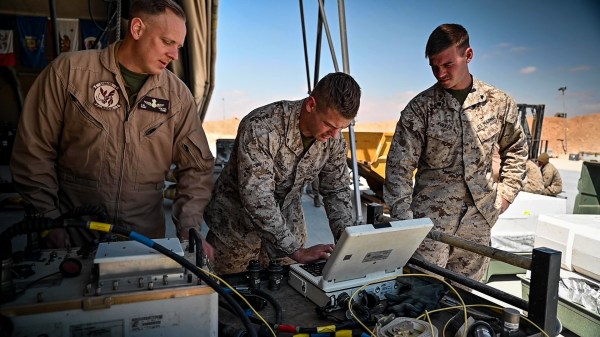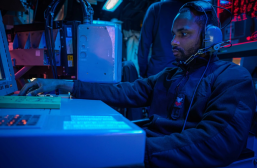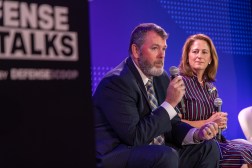Navy aiming to better integrate cyber, info-warfare capabilities with ‘non-kinetic effects teams’ at sea

SAN DIEGO, Calif. — The Navy is looking to build what it calls “fleet non-kinetic effects teams” that will augment afloat forces with critical information warfare capabilities.
The term non-kinetic effects, in U.S. military parlance, generally refers to digital capabilities or tools that don’t fall under the traditional weapons portfolio of physical objects. Today, much of the Navy’s info-warfare capabilities — which include cyber, signals intelligence, information operations and spectrum operations — are employed ashore. However, officials have noted that the service has been grappling with how to integrate these capabilities — especially cyber — with its forces deployed at sea.
“I think in the maritime, we are still maturing and developing how we might integrate cyber capability,” Vice Adm. Kelly Aeschbach, commander of Naval Information Forces, said this week at the annual WEST conference in San Diego.
Chris Cleary, the Navy’s principal cyber advisor, has also acknowledged the need to look at how the service does cyber for the afloat force.
“The Navy is still working through what does cyber at sea look like,” he said last year. “It’s not that the Navy’s not doing these things. It’s just that we are all struggling with what does cyber really mean to our respective service. The Navy is now working through what cyber at sea — a little more specific to Navy missions — really looks like.”
U.S. Cyber Command owns the offensive cyber capabilities within the Department of Defense, and the services conduct offensive cyber ops through Cybercom and the cyber mission forces that each service provides to the command. Some of the services have begun investing in capabilities and forces for their own offensive cyber, however, that is mostly in the blended electronic warfare or radio frequency-enabled sphere.
The Navy has taken big steps to integrate the depth and breadth of broader information warfare capabilities for the fleet, but it’s now looking at a new teaming concept.
“We have a lot of discussion going on right now on what we call ‘fleet non-kinetic effects teams,’ where we’re evaluating what we do from an information warfare perspective afloat,” Aeschbach said. “We are looking at investing in more capacity for EW, for cyber, for IO, with an anticipation of some of the capabilities — like directed energy — that we talked about, and what we might also need to do not just on the net, but at the net and the unique access we bring from the maritime [domain]. I think we’re progressing in that area. We’ve got a study ongoing this year looking at that capability and the integration.”
Other officials hesitated to call these teams purely “service retained” assets, on par with what the other services are doing.
“I don’t know that it would be service retained, and I don’t know that it has to be service retained,” Vice Adm. Craig Clapperton, commander of 10th Fleet/Fleet Cyber Command, told DefenseScoop on the sidelines of the conference.
Given all the hats he wears — Fleet Cyber, Joint Force Headquarters-Cyber Fleet Cyber, which conducts offensive cyber operations on behalf of Cybercom for certain assigned combatant commands, Navy Space Command and the Navy Cyber Warfare Development Group, which provides technical research and development to create, test and deliver cyber and electronic warfare capabilities — he can be the coalescence of all those capabilities.
“If they work for me … they could be service retained because I have a lot of those under my service hat, but they don’t have to be service retained and I can use them under my joint capabilities,” he said.
On the cyber front, Aeschbach noted that in the past there have been challenges with authorities holding up certain operations and thus, the service hasn’t put a lot of energy to invest in capabilities they might not have authority to execute afloat.
For a long time, authority to conduct cyber ops was held at the presidential level and it was very onerous to get approval for an operation. As cyber has matured, those authorities have been improved and some have developed more creative ways to conduct operations such as cyber enabled radio-frequency operations.
“I think that’s maturing also in that environment, that opportunity is changing,” Aeschbach said regarding cyber authorities. “Frankly, we deliver world-class, cyber-capable individuals and we are looking hard at how do we ensure we capture that both in our tactical units and at the operational level in our [maritime operations centers].”
Clapperton said the non-kinetic effects teams and concepts are still being built, largely because he is still awaiting official Senate confirmation to be the head of Navy Space, which the service formalized in January after years of designating the commander of Fleet Cyber as the service’s space component.
These teams are “not only the teams that are going to be potentially in my MOCs, potentially at the tactical edge, but also the planners that are in my headquarters and that would move forward in Indo-Pacom, [Pacific] Fleet, U.S. Forces Korea, wherever they need to,” Clapperton said at the conference. “What I sort of envisioned is the perfect scenario is it’s rotational. I have a group back at my headquarters that are getting refreshed and got up to all the latest and greatest. Then I have groups forward that are helping to integrate this on a daily basis with those combatant commanders. That’s in the planning and the operational level.”
Personnel need to “understand the game” and know how to carry out a variety of activities, when needed, he noted.
“That interactive operator needs to be there,” he said, “but we’re going to need to have teams, non-kinetic teams, that know how to do things on net, know how to do things off net, how to do things in the RF spectrum, how to do things in the space spectrum, EW, and bring all those capabilities to bear together in a synchronized fashion.”
“If you’re relying on a specific access path to deliver an effect, but the EW effect or the space effect takes that path out, oops,” he said. “The bad guys don’t need help. We can’t fratricide our own efforts. It’s really important that those teams [that are] forward understand the game as well and that they operate in a synchronized fashion. That’s how I’m thinking about it. That’s [what] we’re trying to work for.”
This is going to take a bit more resourcing to get together, he said, in terms of capabilities and tools.
He added that they have some cyber teams with these capabilities that can move forward and work in the Joint Mission Operations Center.
“As far as the actual full integration with the space and cyber and EW that I talked about and I sort of envisioned, we’re not there yet,” he said.
Clapperton stressed that the combined power of all these non-kinetic capabilities is greater than the sum of their parts. Alone, they are not as effective.
“No cyber effect on its own is enough,” he said. “It must be synchronized and aligned with space effects. It must be synchronized and aligned with EW effects, information effects. Then you layer that on top … [of] deception and dynamic force maneuvering and decoys, and you create an incredibly complicated environment where we own the electromagnetic spectrum, where we are degrading the adversary’s picture while maintaining ours.”
Ultimately, it’s the combination of kinetic effects and non-kinetic effects that are a winning recipe, in his view.
“Non-kinetics are integrated with the kinetics, and that’s how you win fights in the modern world,” Clapperton said.






